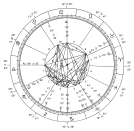Agricultural astrology
| Astrology |
|---|
 New millennium astrological chart |
| Background |
| Traditions |
| Branches |
|
|
Agricultural astrology is a type of electional astrology that advises the planting, cultivating and harvesting of crops based on moon phases and astrological signs. Agricultural astrology is often referred to as "planting by the signs" because of its reliance on astrological signs for planting, cultivating and harvesting.[1]
The Old Farmer's Almanac regularly features a "planting by the signs" section.[2]
History
Agricultural astrology is one of the oldest forms of astrology. It was probably the first use humans made of lunar cycles.[3] Evidence of its practice dates back thousands of years to the ancient peoples of the Nile and Euphrates River valleys. Farmers of these civilizations planted by the Moon's phase and its sign in the zodiac.[4] There is a lack of scientific evidence proving the beneficial effects of astrological gardening. A few studies have been conducted, but "none of this has been conclusively proven or disproved by modern science".[5]
Other uses
Although agricultural astrology is primarily used as a guide for growing crops, it also has been applied to the practice of animal husbandry. For example, agricultural astrology encourages poultry farmers to set up their chicken's eggs to hatch when it is a new moon and in a "fruitful" sign. It claims that chicks hatched during this time grow faster and produce more offspring.[6]
Moon gardeners maintain that not only is science on their side, but also that the results are plain to see. According to the theory, plants that are sown in the few days before a full moon become stronger and more productive. The moon gardeners claim that the gravitational force of the full moon affects the level of groundwater in the soil, just as it does the level of the oceans. With more water being drawn up into the soil during a full moon, any newly sown seeds are boosted by the increased hydration.[7] It should be noted that the phases of the moon do not correspond to the distance of the moon's orbit around the Earth, and hence are not indicators of the strength of the moon's gravitational pull. Instead, apogee and perigee of the moon's orbit are what determines the moon's distance to the Earth.
One of the more notable sources to rely upon this methodology is the annual Farmers' Almanac, which bases its Gardening by the Moon Calendar on the concept of agricultural astronomy.
Notes
- ↑ Lewis 2003, p. 11-12
- ↑ Lewis 2003, p. 13
- ↑ Oken 2006, p. 16
- ↑ Llewellyn 2004, p. 83
- ↑ Planting by the Moon and Signs, University of Florida
- ↑ Llewellyn 2004, p. 91
- ↑ Do plants grow better by the light of a full moon?, dailymail.co.uk
Sources
- Lewis, James (2003). The astrology book: the encyclopedia of heavenly influences. Visible Ink Press. ISBN 1-57859-144-9.
- Llewellyn, George (2004). Powerful Planets Astrologically Considered 1931. Kissinger Publishing. ISBN 1-4179-8253-5.
- Oken, Alan (2006). Alan Oken's Complete Astrology: The Classic Guide to Modern Astrology. Red Wheel/Weiser. ISBN 0-89254-125-3.
References
- Nick Kollerstrom's Gardening and Planting by the Moon (an annual series beginning 1980)
- Marcella Shaffer (2001), Planning & Planting a Moon Garden, Storey Publishing; ISBN 1603423524
- Gloria Star (2001), Llewellyn's Moon Sign Book: And Gardening Almanac, Llewellyn Publications; ISBN 0738700312
- Lyn Bagnall (2012), Easy Organic Gardening and Moon Planting, Scribe Publications; ISBN 1921844787

